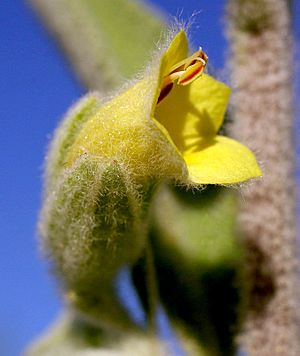Muniria quadrangulata facts for kids
Quick facts for kids Muniria quadrangulata |
|
|---|---|
 |
|
| Flower of Muniria quadrangulata | |
| Scientific classification | |
| Genus: |
Muniria
|
| Species: |
quadrangulata
|
Muniria quadrangulata is a unique flowering plant that belongs to the mint family, called Lamiaceae. You can only find it in a special area of Australia called Arnhem Land in the Northern Territory. This plant is a shrub with branches and leaves that feel very soft because they are covered in thick, woolly hairs. Its flowers are pale yellow and grow in small groups, also surrounded by these woolly hairs.
Contents
About This Plant
Muniria quadrangulata is a shrub that can grow up to about 1 m (3 ft) tall. Its branches have four distinct corners when you look at them in cross-section. The branches, leaves, and even some parts of the flowers are covered with a thick, white, woolly layer of hairs.
Leaves and Flowers
The leaves of this plant are shaped like an oblong or an egg. They are usually 4–8 cm (2–3 in) long and 15–25 mm (0.6–1 in) wide. Their surface looks wrinkled and bumpy, almost like it has small blisters.
The flowers grow in groups of up to nine, and sometimes even twelve. These groups appear in the axils (the angle between a leaf and the stem) near the ends of the branches. Each group of flowers grows on a hairy stalk that is 10–18 mm (0.4–0.7 in) long. Each individual flower also has its own hairy stalk, about 2–3 mm (0.08–0.1 in) long.
Flower Parts
The flowers are surrounded by special leaf-like structures called bracts and bracteoles. These are lance-shaped and covered in woolly hairs. The flower has five sepals, which are like small leaves that protect the bud. They are 10–14 mm (0.4–0.6 in) long and mostly woolly. These sepals are joined together for about half their length, forming a tube. The tips of the sepals are 8–11 mm (0.3–0.4 in) long.
The petals are pale yellow and measure 14–25 mm (0.6–1 in) long. They are joined for most of their length, forming a tube. The outside of this tube is hairy, but the inside is smooth (called glabrous), except for a small ring of hairs around the ovary (where the seeds develop).
At the end of the petal tube, there are five egg-shaped lobes. The lower, central lobe is the largest, about 3–4 mm (0.1–0.2 in) long and 4–6 mm (0.16–0.24 in) wide at its base. The other four lobes are similar in size and shape to each other. Inside the flower, there are four stamens (the parts that produce pollen). The lower pair of stamens is longer than the upper pair, and they reach almost to the end of the petal tube.
Life Cycle
Muniria quadrangulata usually flowers from January to August. After the flowers, the plant produces fruit from January to September. The fruit is oval-shaped and has four clear ridges. The sepals remain attached to the fruit.
How It Got Its Name
This plant was first officially described in 1979 by a scientist named Ahmad Abid Munir. He studied a plant sample collected near a place called Oenpelli. He named it Pityrodia quadrangulata, and his description was published in a scientific journal called Journal of the Adelaide Botanic Gardens.
Later, in 2011, other scientists, Barry Conn, Murray Henwood, and Nicola Streiber, decided that this plant was different enough to belong to a new group, or genus. They created the new genus Muniria and moved this species into it. That's why its name changed to Muniria quadrangulata.
Where It Grows
This plant is only found in Arnhem Land, which is a large area in the Northern Territory of Australia. You can see it growing in famous places like Kakadu and Nitmiluk National Parks.
Conservation Status
Muniria quadrangulata is currently classified as "least concern" under the Territory Parks and Wildlife Conservation Act. This means that, for now, scientists believe there are enough of these plants, and they are not at high risk of disappearing.

